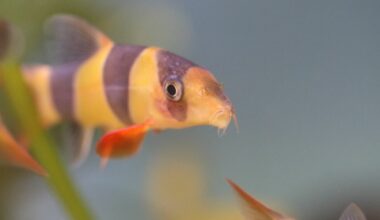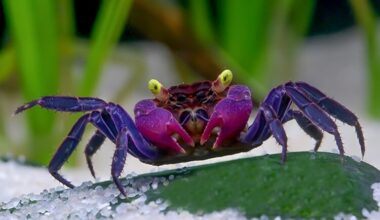Bamboo Shrimp are a neat looking freshwater species that have been in the aquarium scene for quite a while. We recommend them to people all the time because they’re low-maintenance, peaceful, and fun to watch.
But we think this shrimp isn’t as popular as they should be. A lot of people overlook them for more popular species and we’re not totally sure why.
So we made this guide to do two things:
The first is to teach you everything there is to know about Bamboo Shrimp care. By the time you’re done reading this, you’ll be an expert in understanding their habitat, diet, size, water parameters, and even breeding techniques.
The second is to hopefully bring this unique species into the limelight a bit more. They’re one of our favorite shrimps, and we think they deserve more love!
Let’s begin.
Table of Contents
Species Summary
Bamboo Shrimp (Atyopsis moluccensis) are a freshwater species native to Southeast Asia. While they’re scattered all over the region in general, some of the notable locations they’re found in are Sri Lanka, Okinawa, Malaysia, and Thailand.
There are many other names for this animal which can be a bit tough to keep track of. The most common are the Fan Shrimp, Flower Shrimp, Wood Shrimp, Singapore Shrimp, and the Singapore Flower Shrimp.
Because of this, it’s normal for aquarists to think they’re referring to multiple species instead of one.
It’s worth noting that in a lot of countries in Southern Asia this shrimp is actually sought after as a source of food for humans. This can further some of the confusion started by their collection of names because many aquarists don’t know that people eat these!
Lifespan
A normal Bamboo Shrimp lifespan is 1 or 2 years. It’s pretty normal for shrimp to have a short lifespan so this range isn’t anything out of the ordinary.
Author Note: The main factors that influence their lifespan are the quality of care and the source of acquisition. If you purchase your Flower Shrimp from a mediocre seller then there’s a good chance they won’t live as long as they could.
Appearance
The appearance of the Bamboo Shrimp is one of our favorite things about the species. While a lot of people assume that all shrimp look pretty much the same, that’s definitely not the case.
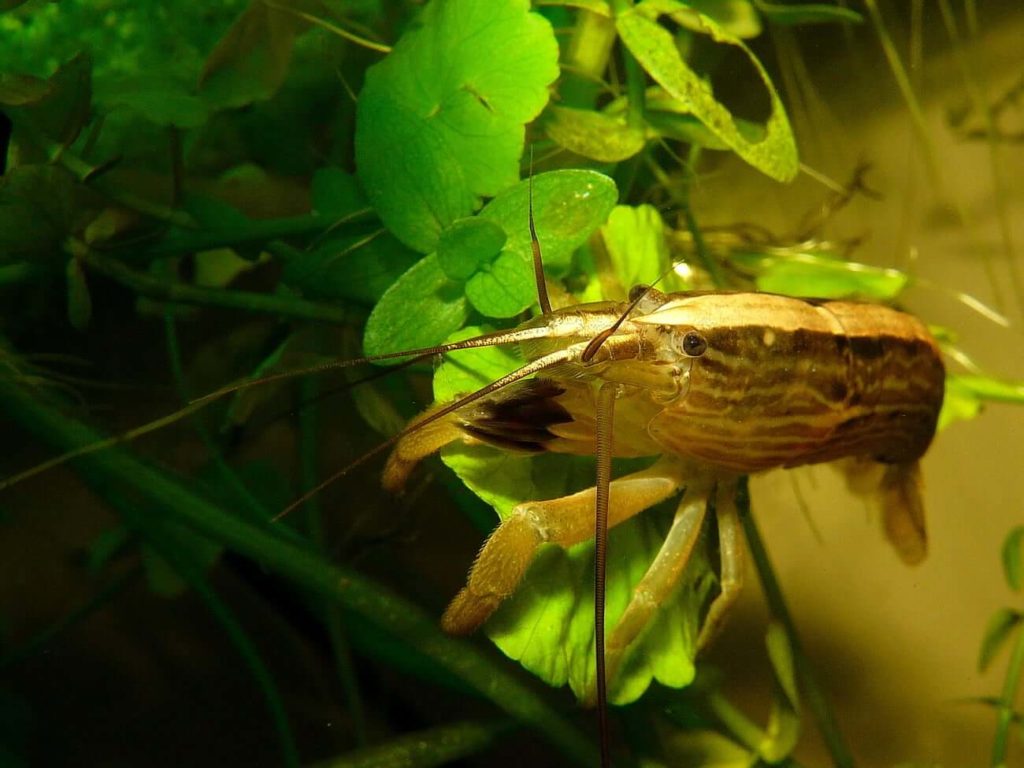
When it comes to their general body type they’re pretty much what you would expect. However, they have a fairly thick body that only tapers off near the end of their tail.
Their coloration can vary depending on the specimen and the area they come from. For the most part, these shrimp are yellow or brown (although there are some that look a bit reddish).
Even bands and streaks run along the side of their body from end to end. Their color will depend on the dominant color of the shrimp, but they’re usually a bit lighter.
The feature that stands out the most on the Bamboo Shrimp is their little fan-like hands (hence the name “Fan Shrimp”).
These serve as mini nets that can be used to easily grab small edible particles and organisms from the water. It’s very mesmerizing to watch these in action, and it’s one of the reasons we like this species so much!
Size
The average Bamboo Shrimp size is around 3 inches when fully grown. These shrimp are actually rather large compared to a lot of the other types of species you see in freshwater aquariums.
You can impact their size by maintaining good water quality and feeding them a healthy and balanced diet. The sooner you can get these shrimp and start taking good care of them the better since there will be fewer uncertainties about the quality of care they received from the seller.
Bamboo Shrimp Care
Bamboo Shrimp care is fairly low-maintenance and can be done by pretty much anyone. There aren’t any odd or unique requirements that you need to meet, so it’s all about being consistent and giving the best habitat possible.
The one thing that takes getting used to is how they feed. We cover the details of this in a later section, but the concept can take a little getting used to.
Author Note: While these shrimp are fairly hardy and easy to take care of, these critters can suffer from serious health complications if they experience a significant change in water parameters. Keep this in mind when adding them to your aquarium.
Tank Size
The ideal tank size for Bamboo Shrimp is around 20 gallons (for each individual shrimp). While some owners regularly keep them in smaller tanks than this, we don’t recommend it.
The primary reason we recommend a little extra tank size is that this species is a little larger than most, and needs some space in order to find food. For most aquatic life, a larger tank is rarely a bad thing!
Lastly, a long tank is better than a deep one. This layout does a better job of facilitating a current which is important for feeding (more on that later).
Water Parameters
Understanding the ideal water parameters for Bamboo Shrimp is very important. Even though they’re pretty hardy low-maintenance, rapidly changing or suboptimal conditions can cause serious problems.
This means consistency is just as important as finding the right parameters. Below are the ranges you should aim for.
- Water temperature: 70°F to 78°F
- pH levels: 6.5 to 8
- Water hardness: 3 to 10 dKH
In order to maintain this consistency, you should check these parameters on a regular basis. This is especially important early on when they might still be adjusting to the new tank conditions.
Setting Up Their Habitat
The most important items to include in the tank with Bamboo Shrimp are plants. These critters are used to a ton of vegetation in their natural habitat, and adding some to your aquarium does a lot more than just making them feel at home.
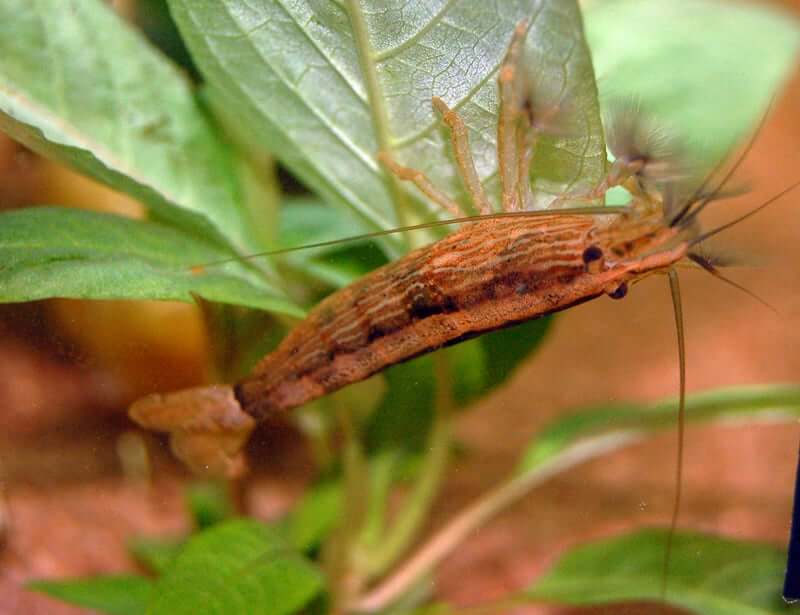
By including plants in their habitat you’re making a lot easier for them to find food naturally (without needing to rely on supplementation). Tiny pieces of plant matter will break off and enter the water for your Fan Shrimp to catch with their little hands!
It’s not uncommon to see this species climbing around on plants as well. They’re comfortable using them as hiding spots in the wild and will get enrichment from interacting with them.
Any of the popular aquarium plants will do fine since these shrimp won’t actually eat them directly.
As for the rest of their habitat, you can be a lot more flexible. Wood Shrimp can handle a variety of substrates which means you can defer to the preference of the other plants and animals they’ll be sharing the aquarium with.
Personally, we like to give them some additional places to hide by including rocks and driftwood. These are more complementary and will help add a little variety to their habitat as well.
Author Note: It’s important to make sure there’s a decent current in their habitat. This allows small organic particles to be moved around in the water for them to grab.
Potential Health Complications
The two main health issues you have to worry about with the Bamboo Shrimp come from big changes or events to their habitat.
One of the common issues that people run into with this species is their sensitivity to water changes. If the water parameters of their habitat suddenly shift, there’s a strong chance it will be fatal.
While this is true for many fish, the Bamboo Shrimp can be particularly affected when this happens (sometimes you’ll get lucky though). That’s why we always recommend that you exercise caution when adding them to your tank. Test the water they’re currently in and do what you can to slowly get them used to their new habitat.
The other issue that can impact the health of this species is copper. Like all shrimp, even the smallest trace of copper in the aquarium water can kill them.
This is a problem because the vast majority of tank medications contain copper in them. That means you could be trying to help another animal in your tank, and accidentally poison your Bamboo Shrimp.
If you’re in the situation where you need to add a medication to your water that contains copper, remove these shrimp first.
Make sure the water parameters of their new tank match their current one as much as possible. Then, make sure all traces of copper are gone from the water before bringing them back to their original home.
Feeding Them
This is where a lot of aquarists get confused. Bamboo Shrimp are filter feeders which simply means they filter out their food from the surrounding water.
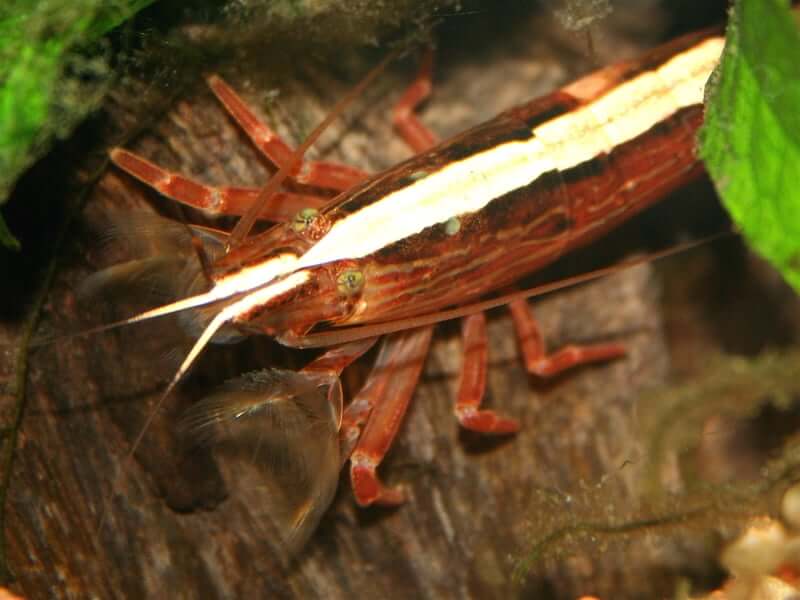
Their ideal diet consists of small organic matter and organisms (like microalgae or plant matter) that float around in the water.
Because of this, your role in the feeding process will be a lot more passive. If you have enough plants in your tank and a suitable current you might not need to feed them at all!
This is where the concept can get a little spooky for some owners. They think they’re neglecting these animals by not dropping food into the tank.
But as long as you’ve set up the tank properly this species should be able to sustain themselves.
If you don’t have the ideal setup for this (maybe you can’t include enough plants for whatever reason) you still have options. Grinding up an algae-based food and dropping it into the tank will do the trick.
Author Note: If you have to supplement their diet make sure you don’t add too much. A large influx of food can lead to high nitrate levels and a series of other problems in your aquarium.
Behavior & Temperament
One of our favorite things about Bamboo Shrimp is how busy they are. These little critters are always scavenging and filtering the water for food.
Watching them closely is very addicting. They always have their little fans out ready to catch something tasty. You might even see this species use their hands to sweep surfaces of rocks or plants that have organic matter on them.
There’s something about their commitment to scavenging that’s really cute! This species is relatively active for a shrimp and will often reposition themselves to find the optimal place to find food.
If you do any work in the substrate or have fish that like to dig, expect to see your Bamboo Shrimp join in on the action. There are a lot of edible goodies resting in the substrate, so these shrimp will often make their way over to take advantage of this.
Tank Mates
There are a ton of tank mate options for Bamboo Shrimp. These creatures don’t want to cause any trouble and will spend their time doing their own thing (aka scavenging).
The traits you’re looking for when it comes to compatible tank mates are a peaceful nature and a nonpredatory relationship. Any fish that’s naturally feisty or sees shrimp as food shouldn’t be in the same tank.
To help get you started we’ve put together a quick list of options for you.
- Cherry Shrimp
- Mystery Snails
- Cory Catfish
- Black Skirt Tetra
- Otocinclus
- Sparkling Gourami
- Ghost Shrimp
- Nerite Snails
- Amano Shrimp
- Honey Gourami
- Ember Tetra
Molting
It’s important to know that these shrimp will go through a molting phase every 45-65 days (roughly). If you’re not aware of this it might take you by surprise!
They’ll always look for a suitable hiding place to do this since attempting out in the open would make them easy prey in the wild. Once you’ve seen this happen a few times it will become obvious that’s what they’re up to if you can’t find them easily.
You can remove their shell if you want, but it’s not necessary. It will degrade and disappear relatively fast (especially if there are other scavengers in the aquarium).
Bamboo Shrimp Breeding
For such a low-maintenance creature, Bamboo Shrimp breeding is quite the nightmare task. Successfully breeding them in captivity is pretty much out of the question.
The primary reason for this is that the larvae need saltwater in order to develop properly. When you combine this with the fact that adults can’t survive in this, you end up with an awkward logistical problem.
While having a separate brackish tank for the larvae might seem like an obvious solution, it’s been tried by other aquarists (many times). We haven’t heard of any successful attempts which means there aren’t any real guidelines to start experimenting with.
Due to the extremely high failure rate we recommend not attempting to breed Bamboo Shrimp at all. If a highly experienced breeder figures out how to do it then we’ll make sure to add their recommendations to this guide.
Conclusion
We hope this guide has taught you the essentials of Bamboo Shrimp care and encouraged you to get some for yourself!
These are some of our all-time favorite freshwater shrimp and we know many other aquarists who feel the same way. Watching them diligently scavenge day in and day out is surprisingly fun.
Take our advice and give this species a shot. You won’t regret it!
